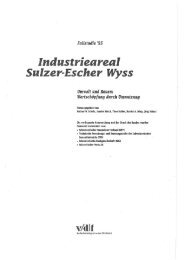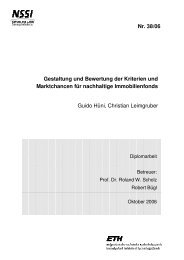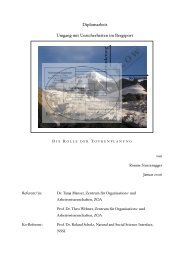The Paradigm of Human-Environment Systems - Natural and Social ...
The Paradigm of Human-Environment Systems - Natural and Social ...
The Paradigm of Human-Environment Systems - Natural and Social ...
You also want an ePaper? Increase the reach of your titles
YUMPU automatically turns print PDFs into web optimized ePapers that Google loves.
Conclusions <strong>and</strong> Outlook<br />
<strong>The</strong> <strong>Paradigm</strong> <strong>of</strong> <strong>Human</strong>-<strong>Environment</strong> <strong>Systems</strong><br />
<strong>The</strong> HES paradigm is a typical approach for dealing with the complexity <strong>of</strong> human environment<br />
dynamics. This section first summarizes the accomplishments <strong>of</strong> the HES paradigm<br />
<strong>and</strong> then discusses its properties <strong>and</strong> implications as they relate to the theory <strong>of</strong> science.<br />
Within the HES paradigm we presented a process-structure model for investigating RFCmechanisms<br />
in <strong>Human</strong>-<strong>Environment</strong> <strong>Systems</strong>. It provides<br />
Structure for HES research: <strong>The</strong> human <strong>and</strong> the social system are considered semiautonomous,<br />
interlinked systems. <strong>The</strong>y are interlinked through different types <strong>of</strong> environmental<br />
awareness <strong>and</strong> different types <strong>of</strong> feedback loops. Feedback results on different time scales.<br />
Multi-level hierarchy <strong>of</strong> the human system: <strong>The</strong> framework includes a hierarchical view <strong>of</strong><br />
the human system. Within each hierarchy level, different regulatory mechanisms with respect<br />
to the environmental system can be encountered <strong>and</strong> have to be defined. <strong>The</strong> underst<strong>and</strong>ing <strong>of</strong><br />
these mechanisms allows for the identification <strong>of</strong> interfering regulatory mechanisms.<br />
A game <strong>and</strong> decision theoretic framework: This framework allows for conceptualizing<br />
human behavior through goal <strong>and</strong> strategy formation, strategy selection, action <strong>and</strong> learning<br />
with respect to the immediate <strong>and</strong> delayed feedbacks <strong>of</strong> the environmental system.<br />
From a theory <strong>of</strong> science perspective, the HES paradigm has significant properties <strong>and</strong><br />
implications.<br />
Integrating quantitative <strong>and</strong> qualitative data <strong>and</strong> knowledge (Tietje & Scholz, 2002): <strong>The</strong><br />
HES paradigm requires a qualitative, conceptual definition <strong>of</strong> the core units <strong>and</strong> their relationship<br />
at the levels under consideration, such as the driving forces in goal formation <strong>and</strong> the<br />
principles <strong>of</strong> strategy selection <strong>and</strong> learning. When using the approach <strong>and</strong> techniques <strong>of</strong> conceptual<br />
game theory or system theory/cybernetics quantitative analysis becomes possible 8 .<br />
Representing equilibration, adaptation, <strong>and</strong> assimilation dynamics: With the HES paradigm<br />
learning mechanisms <strong>and</strong> principles <strong>of</strong> behavioral change can be specified. Thus system<br />
properties such as vulnerability, stability, or resilience can be made explicit.<br />
a) Mastering complexity in system modeling: <strong>The</strong> HES <strong>Paradigm</strong> allows for defining a manageable<br />
set <strong>of</strong> semiautonomous units. <strong>The</strong>refore, the whole system becomes stepwise approachable<br />
by considering only the most essential interactions. This facilitates simplicity in<br />
modeling, in particular <strong>of</strong> the decision-making process within the human systems. In this<br />
context, approaches such as bounded rationality (Simon, 1957; Gigerenzer & Selten, 2001)<br />
provide a good example.<br />
8 Though the historical example <strong>of</strong> the Black Death did not extensively utilize quantitative data, population statistics<br />
would be possible, based on the conceptual model presented. Another approach, which provides spatially explicit<br />
data, has been suggested by Collins (1996).<br />
ETH-UNS Working Paper 37 17

















